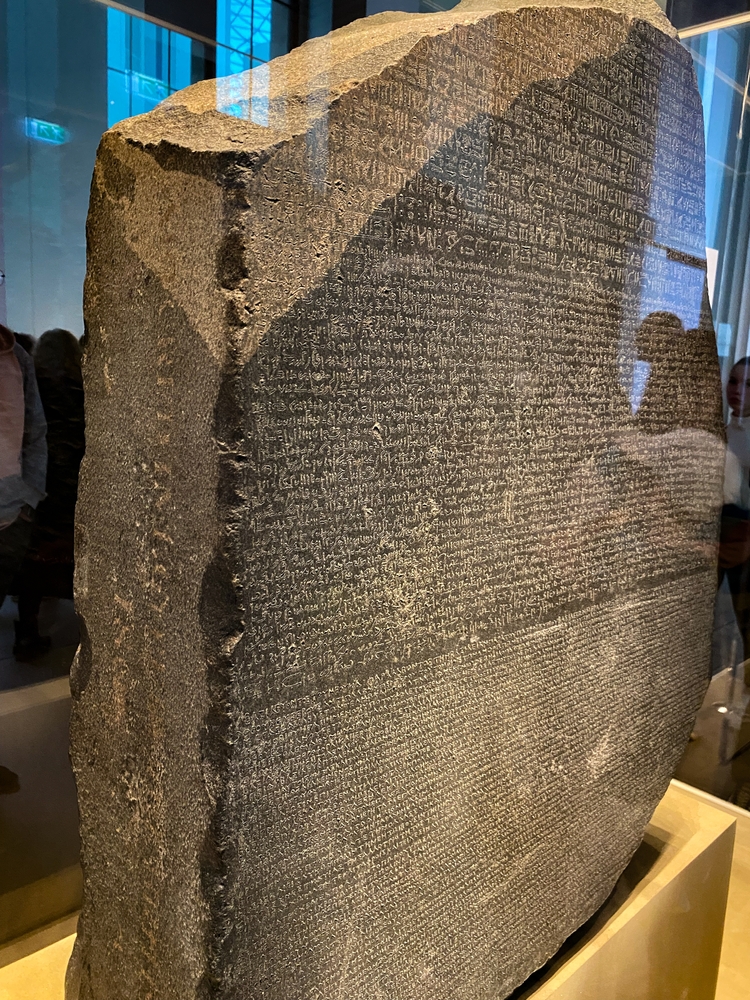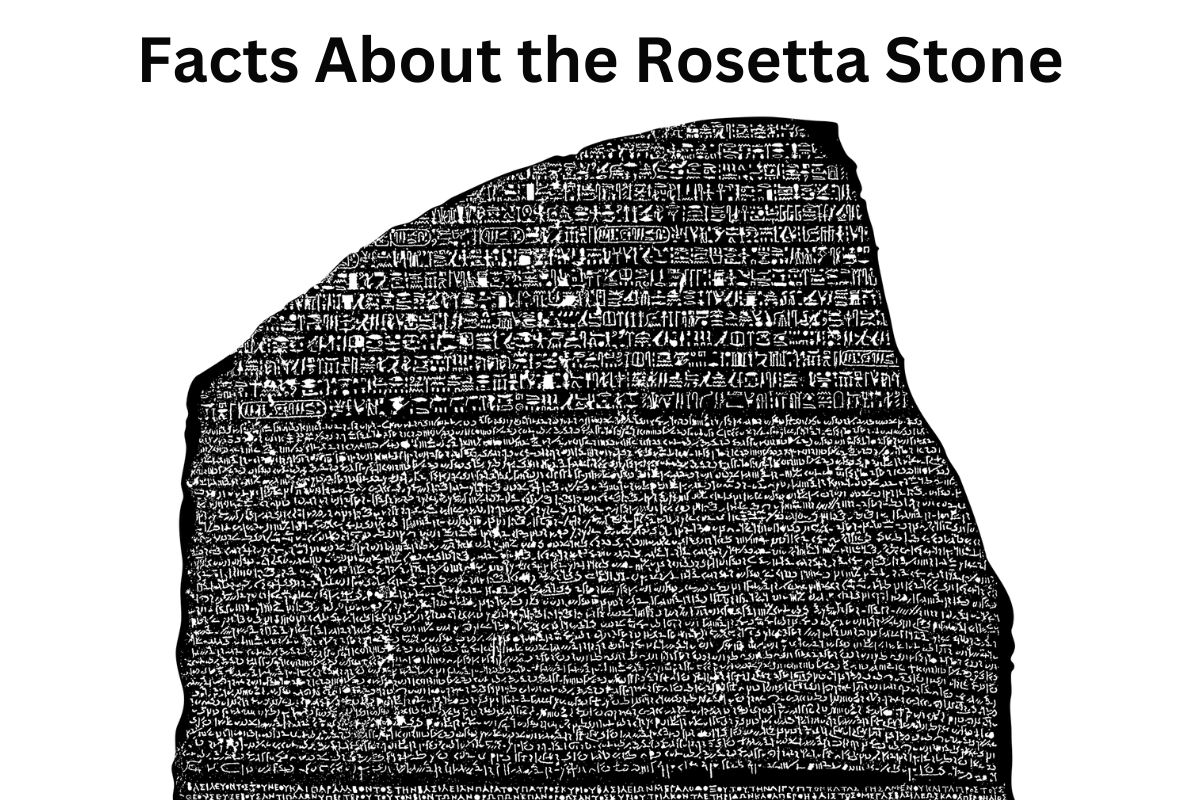The Rosetta Stone is an ancient artifact of immense historical and linguistic importance. Discovered in 1799 during Napoleon’s campaign in Egypt, this black basalt slab with inscriptions in three scripts:
- Ancient Egyptian hieroglyphs
- Demotic script
- Ancient Greek
It played a pivotal role in deciphering Egyptian hieroglyphs. Its decipherment by Jean-François Champollion in 1822 unlocked a wealth of knowledge about ancient Egypt.
Housed in the British Museum since 1802, the Rosetta Stone has become an iconic symbol of decipherment and is revered for its ability to shed light on the rich history and culture of the ancient world.
Rosetta Stone Facts
1. The Rosetta Stone is an ancient artifact that was discovered in 1799
The discovery of the Rosetta Stone in 1799 was a significant event in the field of Egyptology. During the Napoleonic campaign in Egypt, French soldiers were fortifying the town of Rosetta when Bouchard stumbled upon the stone while excavating the foundations of an old wall.
Recognizing its potential importance, Bouchard alerted his superiors, and the stone was quickly transported to Cairo and later acquired by the French Institute in Cairo. However, following Napoleon’s defeat, the stone became the property of the British under the terms of the Treaty of Alexandria in 1801.

2. The stone is a black basalt slab with inscriptions in three different scripts
The Rosetta Stone is an extraordinary artifact that consists of a large black basalt slab. It is a rectangular stone that measures approximately 112.3 cm (44.2 inches) in height, 75.7 cm (29.8 inches) in width, and 28.4 cm (11.2 inches) in thickness.
What makes the Rosetta Stone particularly remarkable is the presence of inscriptions in three distinct scripts on its surface.
3. The inscriptions on the Rosetta Stone are essentially the same text written in three different scripts
The inscriptions on the Rosetta Stone are a unique and significant example of the same text written in three distinct scripts: Ancient Egyptian hieroglyphs, Demotic script, and Ancient Greek. These parallel inscriptions provide a valuable linguistic and comparative resource for scholars.
The text itself is a decree issued by King Ptolemy V Epiphanes, who ruled Egypt from 204 to 180 BCE. Known as the Memphis Decree, it was issued in 196 BCE and serves as a commemoration of Ptolemy V’s ascension to the throne.
The decree outlines the various honors and benefits bestowed upon the young king by the priests of Egypt.
The hieroglyphic section of the Rosetta Stone contains the most complex and visually striking inscriptions. It consists of intricate pictorial symbols representing objects, sounds, and ideas. The Demotic script, a cursive form of writing derived from hieratic script, appears in the middle section of the stone.
This script was used for everyday purposes, such as administrative documents and correspondence. The final section of the stone contains the Ancient Greek text, which was widely known at the time as the language of scholars and the elite.
By comparing the known Greek text with the unknown Egyptian scripts, scholars such as Jean-François Champollion and Thomas Young were able to make significant progress in deciphering the hieroglyphic script.
The Rosetta Stone’s trilingual inscriptions played a crucial role in bridging the gap between ancient Egyptian language and modern understanding. They provided the key necessary to unlock the mysteries of hieroglyphs and opened up a new era of Egyptology, enabling a deeper exploration of ancient Egyptian history, literature, religion, and culture.
4. The decipherment of the Rosetta Stone was a collaborative effort
The decipherment of the Rosetta Stone was a significant achievement in the field of linguistics and Egyptology.
Thomas Young, a British polymath, made important progress by recognizing that some hieroglyphs were alphabetic signs representing sounds, while others were ideographic signs representing ideas or objects. Young’s work laid the foundation for further study.
However, it was Jean-François Champollion, a French scholar, who ultimately deciphered the hieroglyphic script based on his extensive knowledge of Coptic, a later form of the Egyptian language, and his careful examination of the Rosetta Stone.
In 1822, Champollion published his groundbreaking work on the decipherment, cementing his place in history as the decipherer of Egyptian hieroglyphs.
5. The Rosetta Stone was transferred to the British Museum in London in 1802
After the British acquired the Rosetta Stone, it was transferred to the British Museum in London, where it has been on display since 1802. The stone is housed in the Egyptian Antiquities section of the museum and remains one of its most prized and popular exhibits.
It is carefully preserved and protected to ensure its longevity and to allow visitors from around the world to appreciate its historical and linguistic significance. The British Museum has played a crucial role in making the Rosetta Stone accessible to the public and promoting its study and understanding.
6. The stone weighs around 760 kilograms or 1,676 pounds
The physical characteristics of the Rosetta Stone contribute to its historical and archaeological significance. It is a large slab of black basalt measuring approximately 112.3 cm (44.2 inches) in height, 75.7 cm (29.8 inches) in width, and 28.4 cm (11.2 inches) in thickness. The stone is quite heavy, weighing around 760 kilograms (1,676 pounds).
Its size and weight reflect the importance and grandeur associated with royal decrees in ancient Egypt. Despite some damage and missing portions, the remaining inscriptions on the stone provide invaluable linguistic and textual evidence that has contributed to our understanding of ancient Egyptian culture, language, and history.
Scholars continue to study the stone and its inscriptions, using advanced imaging techniques and research methods to unlock further insights into the ancient world.
7. The Rosetta Stone has suffered some damage over the centuries
Over the centuries, the Rosetta Stone has suffered some damage and wear. The edges of the stone are broken, and a significant portion of the text is missing, particularly from the bottom.
This damage likely occurred during the stone’s original use and subsequent burial, as well as during its excavation and transport.
However, despite the missing sections, the remaining inscriptions are still incredibly valuable and provide crucial clues for decipherment and historical analysis.
Scholars have carefully documented and studied the stone, using every available detail to piece together the missing parts and gain a comprehensive understanding of the text.
8. The decipherment of the Rosetta Stone opened up a new understanding of ancient Egyptian history, culture, and language
The decipherment of the Rosetta Stone had a profound impact on the field of Egyptology. It allowed scholars to translate numerous other ancient Egyptian texts, including monumental inscriptions, religious texts, and personal writings.
The ability to read hieroglyphs opened up a vast body of knowledge about ancient Egyptian civilization, ranging from religious beliefs and rituals to administrative practices, art, literature, and more. It revolutionized our understanding of one of the world’s oldest and most fascinating civilizations.
9. The Rosetta Stone has become a symbol of the key to understanding something mysterious or complex
The Rosetta Stone has become an enduring symbol of the key to unlocking hidden knowledge or understanding. Its role in deciphering the mysteries of the ancient Egyptian language and culture has made it an iconic artifact.
The term “Rosetta Stone” is often used metaphorically to refer to any essential clue or breakthrough in understanding a complex problem or system. It serves as a powerful reminder of the importance of historical artifacts and the insights they can provide into the past.
10. While the original Rosetta Stone is housed in the British Museum, replicas and reproductions can be found in various museums and educational institutions worldwide
While the original Rosetta Stone is housed in the British Museum, replicas and reproductions of the stone can be found in various museums and educational institutions worldwide. These replicas serve multiple purposes.
They allow visitors to see and appreciate the stone’s significance without having to travel to London. They also provide opportunities for scholars and researchers around the world to study and analyze the inscriptions firsthand.
Replicas of the Rosetta Stone are often used in educational settings to introduce students to ancient Egyptian history, archaeology, and the process of decipherment. By making the stone’s image and inscriptions widely available, replicas help to disseminate knowledge and promote a broader understanding of the ancient world.
